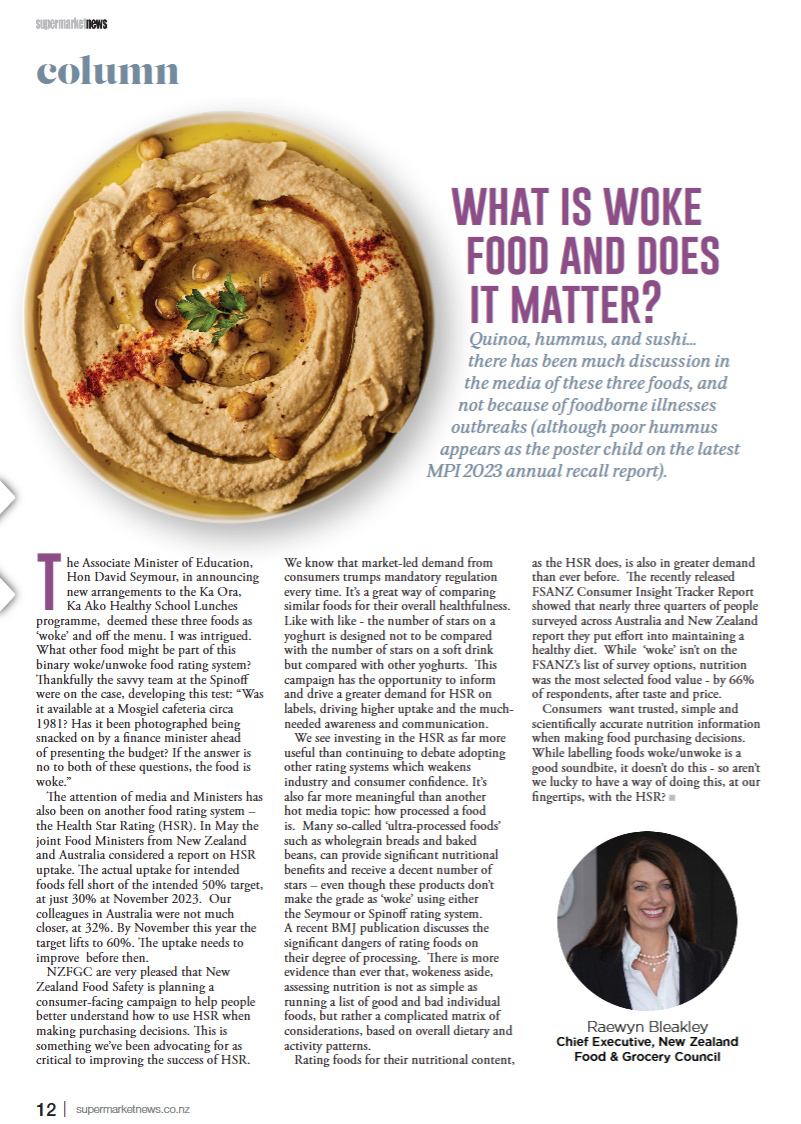Supermarket News Column: What is Woke food and does it matter?
Raewyn Bleakley, Chief Executive
Read more here: MAY 2024 – Supermarket News
Quinoa, hummus, and sushi… there has been much discussion in the media of these three foods, and not because of foodborne illnesses outbreaks (although poor hummus appears as the poster child on the latest MPI 2023 annual recall report). The Associate Minister of Education, Hon David Seymour, in announcing new arrangements to the Ka Ora, Ka Ako Healthy School Lunches programme, deemed these three foods as ‘woke’ and off the menu. I was intrigued. What other food might be part of this binary woke/unwoke food rating system? Thankfully the savvy team at the Spinoff were on the case, developing this test: “Was it available at a Mosgiel cafeteria circa 1981? Has it been photographed being snacked on by a finance minister ahead of presenting the budget? If the answer is no to both of these questions, the food is woke.”
The attention of media and Ministers has also been on another food rating system – the Health Star Rating (HSR). In May the joint Food Ministers from New Zealand and Australia considered a report on HSR uptake. The actual uptake for intended foods fell short of the intended 50% target, at just 30% at November 2023. Our colleagues in Australia were not much closer, at 32%. By November this year the target lifts to 60%. The uptake needs to improve before then.
NZFGC are very pleased that New Zealand Food Safety is planning a consumer-facing campaign to help people better understand how to use HSR when making purchasing decisions. This is something we’ve been advocating for as critical to improving the success of HSR. We know that market-led demand from consumers trumps mandatory regulation every time. The star rating is designed specifically so that each category of food has a range of stars from 0.5 to 5 stars. It’s a great way of comparing similar foods for their overall healthfulness. Like with like – the number of stars on a yoghurt is designed not to be compared with the number of stars on a soft drink but compared with other yoghurts. This campaign has the opportunity to inform and drive a greater demand for HSR on labels, driving higher uptake and the much-needed awareness and communication.
We see investing in the HSR as far more useful than continuing to debate adopting other rating systems which weakens industry and consumer confidence. It’s also far more meaningful than another hot media topic: how processed a food is. Many so-called ‘ultra-processed foods’ such as wholegrain breads and baked beans, can provide significant nutritional benefits and receive a decent number of stars – even though these products don’t make the grade as ‘woke’ using either the Seymour or Spinoff rating system. A recent BMJ publication discusses the significant dangers of rating foods on their degree of processing. There is more evidence than ever that, wokeness aside, assessing nutrition is not as simple as running a list of good and bad individual foods, but rather a complicated matrix of considerations, based on overall dietary and activity patterns.
Rating foods for their nutritional content, as the HSR does, is also in greater demand than ever before. The recently released FSANZ Consumer Insight Tracker Report showed that nearly three quarters of people surveyed across Australia and New Zealand report they put effort into maintaining a healthy diet. While ‘woke’ isn’t on the FSANZ’s list of survey options, nutrition was the most selected food value – by 66% of respondents, after taste and price.
Consumers want trusted, simple and scientifically accurate nutrition information when making food purchasing decisions. While labelling foods woke/unwoke is a good soundbite, it doesn’t do this – so aren’t we lucky to have a way of doing this, at our fingertips, with the HSR?

